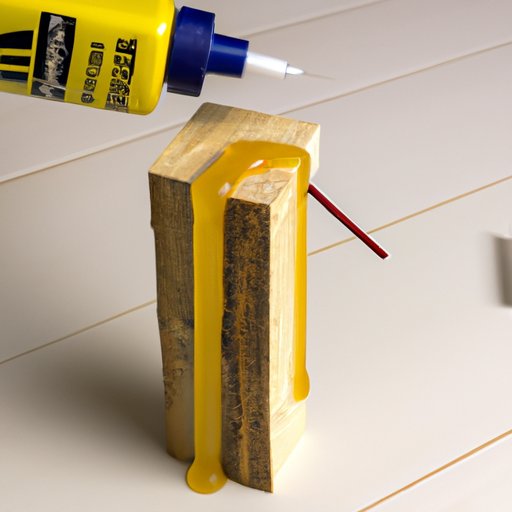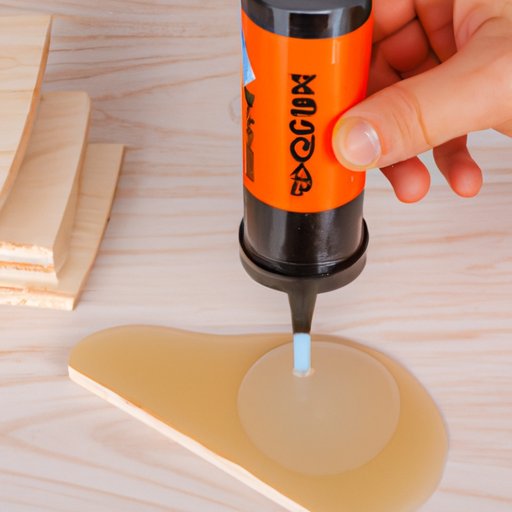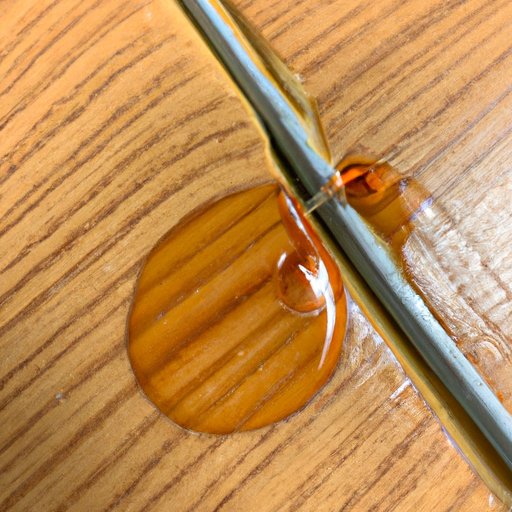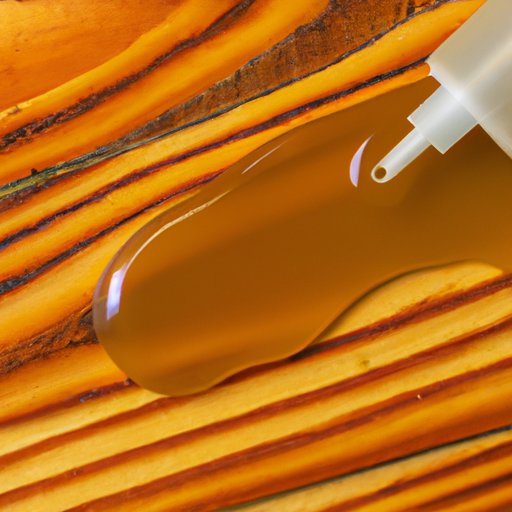Introduction
Wood glue has been used for centuries to join two pieces of wood together. It is a versatile adhesive that can be used to create everything from furniture to toys. Understanding the chemistry of wood glue is an important part of using it correctly. In this article, we will explore how wood glue works, how to use it effectively, and how to choose the best wood glue for your project.
Exploring the Chemistry of Wood Glue
Wood glue is made up of several different components. The main ingredient is an adhesive polymer, which is a long chain of molecules that are designed to bond two surfaces together. This polymer is usually combined with other ingredients such as plasticizers, solvents, and fillers. These additional ingredients help to make the glue more flexible and durable.
When two surfaces are joined together with wood glue, the adhesive polymer forms a strong bond between the two surfaces. The polymer’s molecules wrap around each other and form a net-like structure that holds the two surfaces together. This process is known as “cross-linking” and it is what gives wood glue its strength.
A Guide to Using and Understanding Wood Glue
Using wood glue correctly is essential for achieving the strongest possible bond. Here are some tips to help you get the most out of your wood glue:
- Always read and follow the instructions on the bottle or package before using the glue.
- Clean both surfaces thoroughly before applying the glue to ensure that there is no dirt, dust, or debris present.
- Apply the glue to both surfaces evenly and allow it to dry completely before joining the two pieces together.
- Clamp the two pieces together firmly to ensure a strong bond.
- Allow the glue to cure completely before handling or moving the object.
The curing time for wood glue varies depending on the type of glue and the environmental conditions. Generally, it takes 24 to 48 hours for wood glue to reach its full strength. It is important to allow the glue to cure completely before handling or using the object.

How to Achieve Maximum Strength with Wood Glue
For maximum strength, it is important to choose the right type of wood glue for your project. Different types of glue have different properties and are better suited for certain tasks. Here are some of the most common types of wood glue:
PVA Glues
PVA glues, also known as polyvinyl acetate glues, are the most commonly used type of wood glue. They are water-based adhesives that are easy to apply and provide a strong bond. PVA glues are ideal for general woodworking projects and can be used on a variety of materials, including plywood, particle board, and hardwood.
Hide Glues
Hide glues, also known as animal glues, are made from animal proteins and are the oldest type of wood glue. They provide a very strong bond but can be difficult to apply. Hide glues are best suited for large projects and should not be used on softwoods such as pine or cedar.
Polyurethane Glues
Polyurethane glues are the strongest type of wood glue and are ideal for outdoor projects. They are waterproof and highly resistant to temperature changes, making them perfect for use in humid or wet environments. Polyurethane glues are more expensive than other types of glue and can be difficult to work with.

How to Select the Best Wood Glue for Your Project
Choosing the right type of wood glue for your project is essential for achieving the strongest bond. Here are some tips to help you choose the best glue for your project:
Consider the Type of Joint
The type of joint you are creating will determine the type of wood glue you should use. For example, if you are creating a butt joint (where two pieces of wood come together at a 90-degree angle), a PVA glue will provide the strongest bond. If you are creating a miter joint (where two pieces of wood come together at an angle), a hide glue will provide the strongest bond.
Consider the Type of Wood
The type of wood you are working with will also determine the type of glue you should use. For softwoods such as pine or cedar, a PVA or hide glue will provide the strongest bond. For hardwoods such as oak or mahogany, a polyurethane glue will provide the strongest bond.

Troubleshooting Common Wood Glue Issues
Wood glue can be tricky to work with, so it is important to be prepared for any issues that may arise. Here are some troubleshooting tips for common wood glue problems:
What to Do When Glue Does Not Stick
If the glue does not seem to be sticking, it could be due to a number of factors. First, check to make sure that the surfaces are clean and free of dirt, dust, or debris. Next, make sure that the glue is applied evenly to both surfaces. Finally, make sure that the two pieces are clamped together firmly to ensure a strong bond.
Fixing Gaps in Joints
Gaps in joints can be caused by uneven surfaces or inadequate clamping. To fix gaps in joints, first check to make sure that the surfaces are even. Next, make sure that the pieces are clamped together tightly. Finally, apply additional glue to fill in any gaps. Allow the glue to dry completely before handling or moving the object.
Conclusion
Wood glue is an essential tool for any woodworker or DIYer. By understanding the chemistry of wood glue and learning how to use it correctly, you can achieve the strongest possible bond for your projects. With the tips and information provided in this article, you should have all the knowledge you need to select the best wood glue for your next project.
(Note: Is this article not meeting your expectations? Do you have knowledge or insights to share? Unlock new opportunities and expand your reach by joining our authors team. Click Registration to join us and share your expertise with our readers.)
